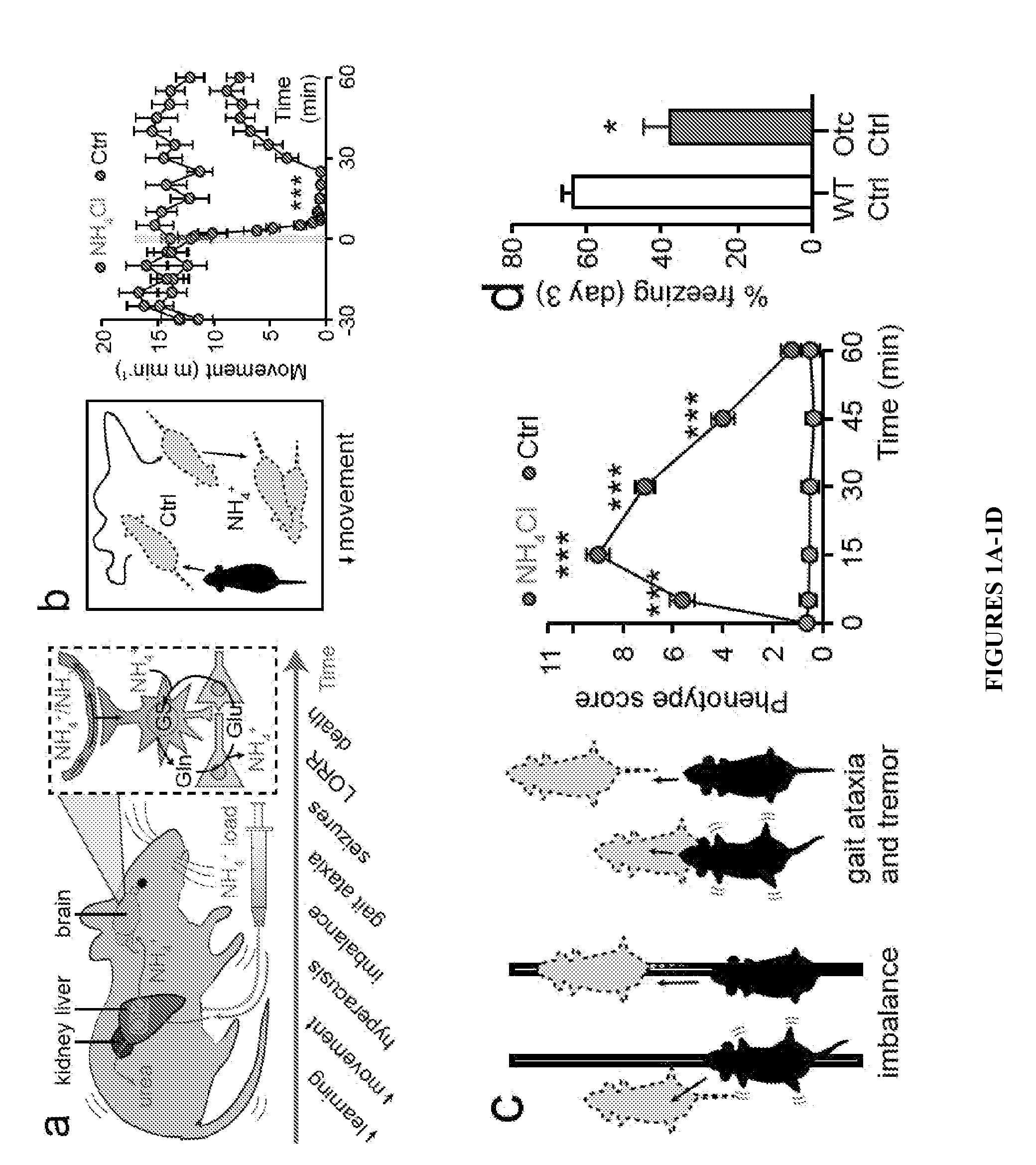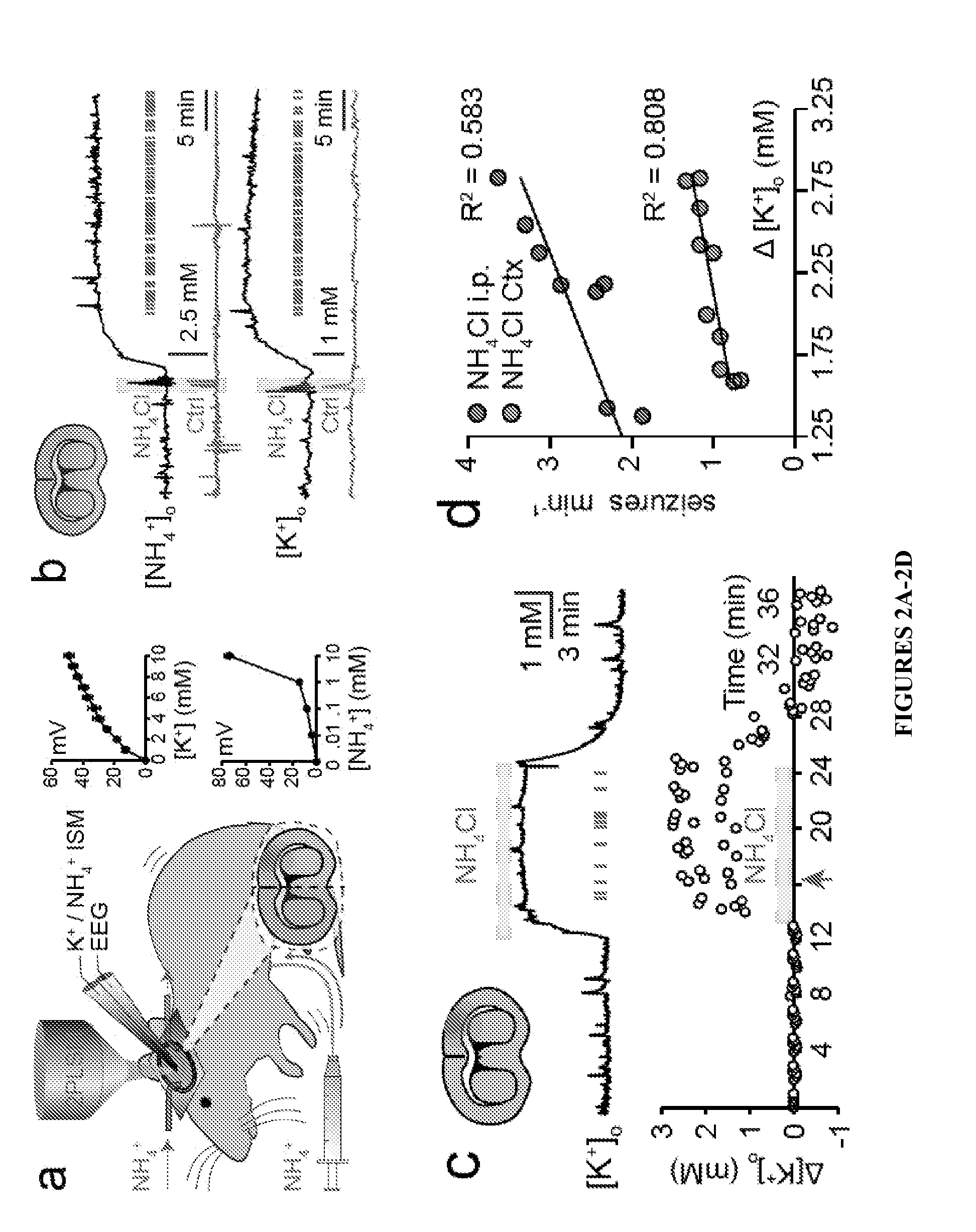METHOD OF TREATING AND PREVENTING BRAIN IMPAIRMENT USING Na+-K+-2Cl- COTRANSPORTER ISOFORM 1 INHIBITORS
- Summary
- Abstract
- Description
- Claims
- Application Information
AI Technical Summary
Benefits of technology
Problems solved by technology
Method used
Image
Examples
example 1
Materials and Methods
[0066]Rodent Breeding and Behavioral Studies
[0067]All animal experiments were approved by the Animal Care and Use Committee of the University of Rochester. Otcspf-ash B6 C3-F1 mice and wild-type littermates were bred as described previously (see Ye et al. “Adenovirus-Mediated In Vivo Gene Transfer Rapidly Protects Ornithine Transcarbamylase-Deficient Mice From an Ammonium Challenge,”Pediatr. Res. 41:527-535 (1997), which is hereby incorporated by reference in its entirety). Aqp4− / − mice and wild-type littermates were generated as described previously (Thrane et al., “Critical Role of Aquaporin-4 (AQP4) in Astrocytic Ca2+ Signaling Events Elicited by Cerebral Edema,”Proc. Natl. Acad. Sci. U.S.A. 108:846-851 (2010), which is hereby incorporated by reference in its entirety). Cortical slices were prepared from P21-30 C57BL / 6J mice as outlined previously (Thrane et al., “Critical Role of Aquaporin-4 (AQP4) in Astrocytic Ca2+ Signaling Events Elicited by Cerebral Ede...
example 2
The Otcspf-ash Mouse Model is Characterized by Acute Ammonia Neurotoxicity
[0091]To characterize the effects of ammonia on brain function, awake adult male Otespf-ash mice were subjected to an acute systemic ammonia load (NH4Cl or NH4Ac, 7.5 mmol kg−1 i.p.). This model was associated with a brisk increase in the extracellular ammonia concentration ([NH4+]o) from 0.32±0.07 to 4.21±0.59 mM in plasma and 0.54±0.18 to 4.83±0.52 mM in brain (FIGS. 5A-5D). Shortly after the injection, the mice developed a stereotypical sequence of neurological impairments, ranging from decreased spontaneous movement to seizures, and in severe cases coma followed by death (FIG. 1A) (Rowe et al., “Natural History of Symptomatic Partial Ornithine Transcarbamylase Deficiency,”New Eng. J. Med. 314:541-547 (1986), which is hereby incorporated by reference in its entirety). Several behavioral measures were employed to track the progression and severity of ammonia neurotoxicity. Using automated video tracking an e...
example 3
Acute Ammonia Exposure Causes a Robust Seizure Phenotype
[0092]In addition to cognitive, sensory, and motor impairment, children with OTC deficiency typically develop seizures during episodes of hyperammonemia (Cagnon et al., “Hyperammonemia-Induced Toxicity for the Developing Central Nervous System,”Brain Res. Rev. 56:183-197 (2007); Rowe et al., “Natural History of Symptomatic Partial Ornithine Transcarbamylase Deficiency,”New Eng. J. Med. 314:541-547 (1986), which are hereby incorporated by reference in their entirety). Around weaning Otcspf-ash mice also developed spontaneous myoclonuses, which are brief (,” Ann. Neurol. 72(2):175-83 (2012); DeSalvo et al., “Focal BOLD fMRI Changes in Bicuculline-Induced Tonic-Clonic Seizures in the Rat,”Neurolmage 50:902-909 (2010), which are hereby incorporated by reference in their entirety). An ammonia challenge was used to precipitate the seizure phenotype and it was found that intermediate doses (7.5 mmol kg−1) triggered numerous myoclonic ...
PUM
 Login to View More
Login to View More Abstract
Description
Claims
Application Information
 Login to View More
Login to View More - R&D
- Intellectual Property
- Life Sciences
- Materials
- Tech Scout
- Unparalleled Data Quality
- Higher Quality Content
- 60% Fewer Hallucinations
Browse by: Latest US Patents, China's latest patents, Technical Efficacy Thesaurus, Application Domain, Technology Topic, Popular Technical Reports.
© 2025 PatSnap. All rights reserved.Legal|Privacy policy|Modern Slavery Act Transparency Statement|Sitemap|About US| Contact US: help@patsnap.com



